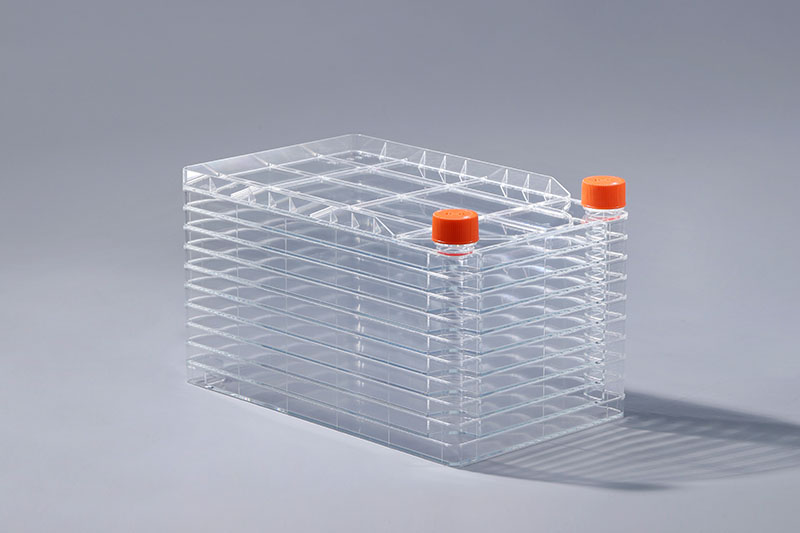लेंटवायरस एक प्रकार का वायरल वेक्टर है जो मानव इम्यूनोडिफीसिअन्सी वायरस (एचआईवी) से संशोधित होता है, जो एक प्रकार का रेट्रोवायरस है। इन विट्रो प्रयोगों और विवो प्रयोगों में, लेंटिवायरस बहिर्जात जीन या बहिर्जात shRNA को व्यक्त करने के लिए आमतौर पर इस्तेमाल किए जाने वाले वैक्टरों में से एक बन गया है, और इसका अधिक से अधिक व्यापक रूप से उपयोग किया जा रहा है। इसके बड़े पैमाने पर उत्पादन में, सेल फैक्ट्री मुख्य रूप से लेंटिवायरल वैक्टर के विस्तारित उत्पादन के लिए लागू होती है। यह सेल कल्चर के सतह क्षेत्र को बढ़ा सकता है, जिससे वेक्टर की उपज में वृद्धि हो सकती है, ट्रांसफेक्शन और पोस्ट-ट्रांसफेक्शन माध्यम प्रतिस्थापन के समय की संख्या कम हो सकती है, और श्रम लागत कम हो सकती है। यह एक कुशल और सुविधाजनक सेल कल्चर है जो उपभोग योग्य है। , और टीके। आमतौर पर इस्तेमाल किया जाने वाला सेल कल्चर है। क्रम। संक्रामकता के संदर्भ में, यह प्रभावी रूप से न्यूरोनल कोशिकाओं, हेपेटोसाइट्स, कार्डियोमायोसाइट्स, ट्यूमर कोशिकाओं, एंडोथेलियल कोशिकाओं, स्टेम कोशिकाओं और अन्य प्रकार की कोशिकाओं को संक्रमित कर सकता है, ताकि अच्छे जीन थेरेपी प्रभाव प्राप्त हो सकें। कुछ मुश्किल-से-संक्रमण कोशिकाओं के लिए, जैसे कि प्राथमिक कोशिकाएं, स्टेम सेल, अविभाजित कोशिकाएं, आदि, लेंटिवायरल वैक्टर के उपयोग से लक्ष्य जीन या लक्ष्य shRNA की पारगमन क्षमता में काफी सुधार हो सकता है, और लक्ष्य जीन या लक्ष्य shRNA कर सकते हैं मेजबान सेल में एकीकृत किया जा सकता है। जीनोम की संभावना बहुत बढ़ जाती है, और लक्ष्य जीन या लक्ष्य shRNA की दीर्घकालिक और स्थिर अभिव्यक्ति को अधिक आसानी से और जल्दी से महसूस किया जा सकता है।
Lentiviral vectors can effectively integrate exogenous genes or exogenous shRNAs into the host chromosome, so as to achieve the effect of persistently expressing target sequences. In terms of infectivity, it can effectively infect neuronal cells, hepatocytes, cardiomyocytes, tumor cells, endothelial cells, stem cells and other types of cells, so as to achieve good gene therapy effects. For some difficult-to-transfect cells, such as primary cells, stem cells, undifferentiated cells, etc., the use of lentiviral vectors can greatly improve the transduction efficiency of the target gene or target shRNA, and the target gene or target shRNA can be integrated into the host cell. The probability of the genome is greatly increased, and the long-term and stable expression of the target gene or target shRNA can be realized more conveniently and quickly.
The cell factory is mainly applied to the expanded production of lentiviral vectors. It can increase the surface area of cell culture, thereby increasing the yield of the vector, reducing the number of times of transfection and post-transfection medium replacement, and reducing labor costs. It is an efficient and convenient cell culture consumable.
In addition to being applied to the large-scale production of lentiviral vectors, cell factories play an important role in the large-scale production of cell therapy, gene therapy, oncolytic virus therapy, and vaccines.
The FAI climbed 5.9 percent year-on-year in the first 11 months of 2018, quickening from the 5.7-percent growth in Jan-Oct, the National Bureau of Statistics (NBS) said Friday in an online statement.
The key indicator of investment, dubbed a major growth driver, hit the bottom in August and has since started to rebound steadily.
In the face of emerging economic challenges home and abroad, China has stepped up efforts to stabilize investment, in particular rolling out measures to motivate private investors and channel funds into infrastructure.
Friday's data showed private investment, accounting for more than 60 percent of the total FAI, expanded by a brisk 8.7 percent.
NBS spokesperson Mao Shengyong said funds into weak economic links registered rapid increases as investment in environmental protection and agriculture jumped 42 percent and 12.5 percent respectively, much faster than the average.
In breakdown, investment in high-tech and equipment manufacturing remained vigorous with 16.1-percent and 11.6-percent increases respectively in the first 11 months. Infrastructure investment gained 3.7 percent, staying flat. Investment in property development rose 9.7 percent, also unchanged.
 English
English



















































